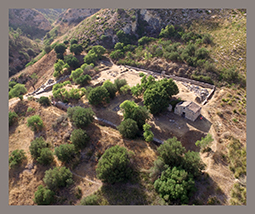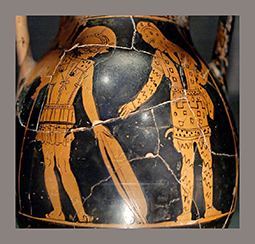Authors: M. de Cesare, B. Bechtold, P. Cipolla, M. Quartararo
Download article as .pdf: Segesta e il mondo greco coloniale attraverso lo studio delle anfore greco-occidentali da aree sacre: primi dati
This research focuses on western Greek wine amphorae found in Segesta, in two Archaic-Classical  sanctuaries which have provided still unpublished archaeological data: the sacred area of the Northern Akropolis documented by the so-called Grotta Vanella dump and the extra-urban sanctuary of Contrada Mango. The amphorae fragments have been studied according to the standardised methods implemented for the data base of FACEM and attributed to more or less-known typologies and provenances. The study of these finds has been accompanied by a systematical review of all published western Greek amphorae yielded by the stratigraphical excavations undertaken in the 1990ties in some urban areas of Segesta. This analysis has led to a better understanding of the commercial vectors and the mechanisms of purchase of these vessels in the Elymian town against the background of the circulation of this class in Sicily and southern-central Mediterranean. Furthermore, the contextualisation of the new data within the frame of the two sanctuaries has allowed for a more precise and diachronic definition of the containers’ role and their contents in the ritual practices. It has also clarified certain dynamics of contact between Segesta and the Greek milieu and the cultural interaction between the Greek and the ‘Indigenous’ population, ritualised within the two sacred areas.
sanctuaries which have provided still unpublished archaeological data: the sacred area of the Northern Akropolis documented by the so-called Grotta Vanella dump and the extra-urban sanctuary of Contrada Mango. The amphorae fragments have been studied according to the standardised methods implemented for the data base of FACEM and attributed to more or less-known typologies and provenances. The study of these finds has been accompanied by a systematical review of all published western Greek amphorae yielded by the stratigraphical excavations undertaken in the 1990ties in some urban areas of Segesta. This analysis has led to a better understanding of the commercial vectors and the mechanisms of purchase of these vessels in the Elymian town against the background of the circulation of this class in Sicily and southern-central Mediterranean. Furthermore, the contextualisation of the new data within the frame of the two sanctuaries has allowed for a more precise and diachronic definition of the containers’ role and their contents in the ritual practices. It has also clarified certain dynamics of contact between Segesta and the Greek milieu and the cultural interaction between the Greek and the ‘Indigenous’ population, ritualised within the two sacred areas.
 This work aims to investigate the cultural systems that emerged from the interaction between Greek and Adriatic populations, using the heroic figure of Diomedes as a key interpretative lens. Deeply rooted along the Adriatic arc of the Italian peninsula, Diomedes represents a cultural bridge between the East and the West. Through the analysis of the mythical and ritual structures and the traditions associated with Diomedes, the study seeks to reconstruct the processes of exchange and transformation that characterized the intercultural dynamics of the ancient Mediterranean.
This work aims to investigate the cultural systems that emerged from the interaction between Greek and Adriatic populations, using the heroic figure of Diomedes as a key interpretative lens. Deeply rooted along the Adriatic arc of the Italian peninsula, Diomedes represents a cultural bridge between the East and the West. Through the analysis of the mythical and ritual structures and the traditions associated with Diomedes, the study seeks to reconstruct the processes of exchange and transformation that characterized the intercultural dynamics of the ancient Mediterranean.
